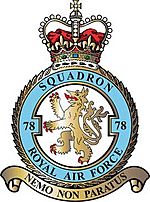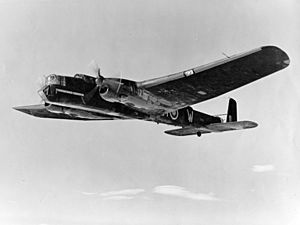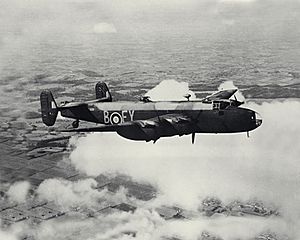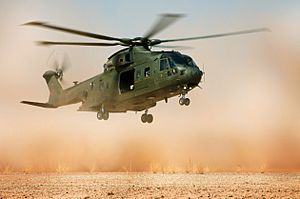No. 78 Squadron RAF facts for kids
Quick facts for kids No. 78 Squadron RAF |
|
|---|---|

No. 78 Squadron badge
|
|
| Active | 1 November 1916 – 1 April 1918 (RFC) 1 April 1918 – 31 December 1919 (RAF) 1 November 1936 – 30 September 1954 15 April 1956 – 1 December 1971 22 May 1986 – December 2007 24 January 2008 – 30 September 2014 2021 – present |
| Country | |
| Branch | |
| Home station | RAF(U) Swanwick |
| Motto(s) | Latin: Nemo non paratus ("Nobody unprepared") |
| Battle honours | *Honours marked with an asterisk are those emblazoned on the Squadron Standard |
| Insignia | |
| Squadron badge | An heraldic tiger rampant and double queued. |
| Squadron badge heraldry | Approved by King George VI in November 1939. |
| Squadron codes | KA (Feb 1939 – Sep 1939) YY (Nov 1936 – Sep 1939) EY (Sep 1939 – Apr 1950) SA–SZ (May 1986 – Dec 2007) |
No. 78 Squadron is a special unit of the Royal Air Force (RAF). It's currently based at Swanwick in Hampshire. Since 2021, it has been involved in military air traffic control.
Before 2021, from 2008 to 2014, the squadron flew large helicopters called Merlin HC3/3As from RAF Benson. These helicopters were later given to the Royal Navy.
From 1986 to 2007, No. 78 Squadron was based in the Falkland Islands. There, they operated Sea King HAR3 helicopters and, until 2006, Chinook HC2 helicopters.
Contents
History of No. 78 Squadron
First World War Service
No. 78 Squadron first formed on 1 November 1916. It was part of the Royal Flying Corps, which was the UK's air force at the time. Their main job was to protect the southern coast of England during the First World War.
The squadron started with older planes like the B.E.2 and B.E.12 biplanes. Later, they received Sopwith 1½ Strutters and Sopwith Camels. In September 1917, the squadron moved to Sutton's Farm. After the war ended, the squadron was officially closed down on 31 December 1919.
Reforming for the Second World War
No. 78 Squadron was brought back to life on 1 November 1936, before World War II began. They were based at RAF Boscombe Down. In 1937, they moved to RAF Dishforth in Yorkshire and became part of RAF Bomber Command. They were equipped with Armstrong Whitworth Whitley night bombers.
When the Second World War started, the squadron first trained new pilots. In July 1940, they became a front-line night bomber squadron again. In February 1941, their Whitleys helped drop paratroopers over Italy. This was for Operation Colossus, the first British paratrooper mission of the war. In September 1941, the squadron flew its first bombing raid against Berlin.
In early 1942, the squadron started using larger, four-engine planes called Handley Page Halifaxes. Their first mission with the Halifax was against Ostend in April 1942. On 30/31 May 1942, No. 78 Squadron sent 22 Halifaxes to Operation Millennium. This was the first "1,000 bomber" raid, targeting Cologne.
In June 1943, the squadron moved to RAF Breighton. In January 1944, they got improved Halifax B.IIIs. These planes had more powerful engines. The squadron continued bombing German cities and helping ground forces during the invasion of France in 1944. By the end of the war, the squadron had dropped 17,000 tonnes of bombs. They flew 6,337 missions and lost 182 aircraft.
Transport and Helicopter Missions (1945–2014)
After World War II ended in Europe, No. 78 Squadron changed its role. In May 1945, they became a transport squadron. They started using Douglas Dakota Mk.IVs to fly supplies and people around the Middle East. They also flew Air-Sea Rescue missions over the Eastern Mediterranean.
In April 1950, they switched to Vickers Valetta C.1 planes. The squadron was closed down on 30 September 1954.
The squadron was brought back again on 15 April 1956. They were based in Aden and flew Pioneer CC.1 transport planes. Later, they used larger Twin Pioneer CC.1s. In 1965, they became a helicopter unit, flying the Wessex. They helped the army and performed Search and Rescue missions. The squadron was closed down again on 1 December 1971.
Helicopter Operations (1986–2014)
No. 78 Squadron reformed on 22 May 1986. This happened when two other flights, operating Chinook and Sea King HAR.3 helicopters, joined together. They were based at RAF Mount Pleasant in the Falkland Islands.
In December 2007, No. 78 Squadron changed its name back to its previous identity. A new No. 78 Squadron was then created on 28 January 2008 at RAF Benson. This new squadron flew AgustaWestland Merlin HC3 and HC3A helicopters. They shared a fleet of twenty-eight Merlin helicopters with another squadron.
The squadron's Merlins were later transferred to the Royal Navy. Because of this, No. 78 Squadron was closed down on 30 September 2014. On 24 March 2020, the squadron received a special award called a battle honour. This was for their important role in the War in Iraq between 2003 and 2011.
Military Air Traffic Control (2021 – Present)
Since early 2021, the No. 78 Squadron name has been given to RAF (Unit) Swanwick. This unit works within the civilian London Area Control Centre in Swanwick. They provide military air traffic control services across the United Kingdom.
Aircraft Operated by No. 78 Squadron
- 1916–1917 Royal Aircraft Factory BE.2c and BE.2e
- 1916–1918 Royal Aircraft Factory BE.12 and BE.12a
- 1917-1917 Royal Aircraft Factory SE.5a
- 1917–1918 Sopwith 1½ Strutter
- 1917-1917 Royal Aircraft Factory FE.2d
- 1917–1918 Royal Aircraft Factory BE.12b
- 1918–1919 Sopwith Camel
- 1918–1919 Sopwith Snipe
- 1936–1937 Handley Page Heyford III
- 1937–1939 Armstrong Whitworth Whitley I
- 1939–1940 Armstrong Whitworth Whitley IVA
- 1939–1942 Armstrong Whitworth Whitley V
- 1942–1944 Handley Page Halifax II
- 1944–1945 Handley Page Halifax III
- 1945-1945 Handley Page Halifax IV
- 1945–1950 Douglas Dakota
- 1950–1954 Vickers Valetta C1
- 1956–1959 Scottish Aviation Pioneer CC1
- 1958–1965 Scottish Aviation Twin Pioneer CC1
- 1965–1971 Westland Wessex HC2
- 1986–2006 Boeing Chinook HC2
- 1986–2007 Westland Sea King HAR3
- 2007–2014 AgustaWestland Merlin HC3/HC3A
See also
- List of Royal Air Force aircraft squadrons
- Military of the Falkland Islands




